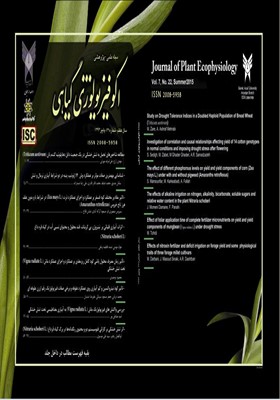-
-
List of Articles
-
Open Access Article
1 - Study on Drought Tolerance Indices in a Doubled Haploid Population of Bread Wheat (Triticum aestivum)
M. Zare علی Ashraf Mehrabi -
Open Access Article
2 - Investigation of correlation and causal relationships affecting yield of 14 cotton genotypes in normal conditions and imposing drought stress after flowering
saman sedigh Mohammad zabed M.Gh Ghaderi A. Samadzadeh -
Open Access Article
3 - The effect of different phosphorous fertilizer on yield and yield components of corn (Zea mays L.) under with and without pigweed (Amaranths retroflexus)
سیروس منصوری فر مسعود کرکه آبادی A. Fallah -
Open Access Article
4 - The effects of alkaline irrigation on nitrogen, alkalinity, bicarbonate, soluble sugars and relative water content in the plant Nitraria schoberi
J. Moemeni F. Panahi -
Open Access Article
5 - Effect of foliar application time of complete fertilizer micronutrients on yield and yield components of mungbean(Vigna radiata L.) under drought stress
mahmood tohidi -
Open Access Article
6 - Effects of Nitroxin Fertilizer and Deficit Irrigation on forage yield and some Physiological traits of three Forage Millet Cultivars
mohammad darbani جعفر مسعود سینکی علیرضا دشتبان -
Open Access Article
7 - Study the physiological responses of mung bean (Vigna radiata L.) as affected by irrigation with magnetized water under drought stress
Omid Sadeghipour -
Open Access Article
8 - Impact of drought stress on photosystem II efficiency and pigment contents in Nitraria schoberi L. Plants
Abolfazl Ranjbar fordoei Seyyed Ali Mousavi -
Open Access Article
9 - Investigation of Effects of Bio Fertilizer Application on Zinc uptake and Some of Vegetative Growth Indices of Corn (Zea Mays L.) in a Non-Sterile Calcareous Soil with Different Levels of Salinity
H.R. Bostani mostafa chorom abdolamir moezzi najafali karimian naimeh enayati zamir mehdi zarei -
Open Access Article
10 - Effect of saline water and chemical fertilizers on nutrient uptake and yield of ajowan (Carum copticum (L.) C. B. Clarke)
madine bizhani parviz yadollahi dehchechme M. Heidari M. Latifi M.R. Asgharipor M. Ramroodi -
Open Access Article
11 - Effect of abscisic acid on seed germination, callus culture and somatic embryogenesis of rapeseed (Brassica napus L.) genotypes under salinity stress
Ali-Ashraf Mehrabi Mansoor Omidi Badredin Tabatabaei زینب صفری -
Open Access Article
12 - The determination and measurement of some secondary metabolites of leaves, stems and roots of Dendrostellera lessertii(Wikstr)Van. Tigeh. and allelopathy effects on barley and mungbean plants
B. Delnavaz O. Ataei M. Mojdehi -
Open Access Article
13 - Effect of phosphate and nitrogen fertilizer levels on the leaves and branches fresh and dry matter and essential oil Brazmbl (Perovskia abrotanoides L).
S.R. Jafari M. Nikkhah Gh.R. Zarei A. Zarezadeh -
Open Access Article
14 - Effects of vermicompost ,microorganisms mycorrhiza and phosphate biofertilizer on morphophysiological characteristics and seed protein percentage of chickpea in the autumn plantation
payam pezeshkpour M.R. Ardakani F. Paknejad S. Vazan -
Open Access Article
15 - Effects of sulfur, vermicompost + Thiobacilus bacteria on some chemical properties of calcareous soil and phosphorus use efficiency of black seed
S.M. Seiedi P. Rezvani Moghadam M. Khaje Hosseini حمید شاهنده -
Open Access Article
16 - Effect of silver nanoparticles on vegetative growth indices and physiological parameters of canola (Brassica napus L.) under in vitro condition
R. Razavi zadeh Z. Tabatabaei F. Rostami -
Open Access Article
17 - Evaluation of morphological traits, yield and yield components of soybean genotypes (Glycine max L.) in Parsabad Moghan region
Mehdi Aghighi Shahverdi F. Abassi Shahmersi B. Mamivand -
Open Access Article
18 - Estimated extinction coefficient, radiation use efficiency and dry matter production coefficients rapeseed plant (Hyola 401) in Khuzestan
حسین کمایی علیرضا ابدالی مشهدی جعفر پوررضا داود امیدی نسب -
Open Access Article
19 - Life cycle assessment of peanut production in sole cropping and mixed intercropping with bean systems
Saeed Firouzi Amin Nikkhah -
Open Access Article
20 - Effects of cultural planting date and on yield and yield components of strawberry in organic production (in Hashtgerd climate condition)
seyed morteza zahedi Zeinab Nazemi Zeinab Houshmand Panah -
Open Access Article
21 - Determine of Impacts factors on limitation of distribution species Kelussia odoratissima mozaff. in Kohgiluyeh
E. Jahantab A. Sepehri M. Mesdaghi حسین بارانی A. Bagheri
-
The rights to this website are owned by the Raimag Press Management System.
Copyright © 2021-2025







